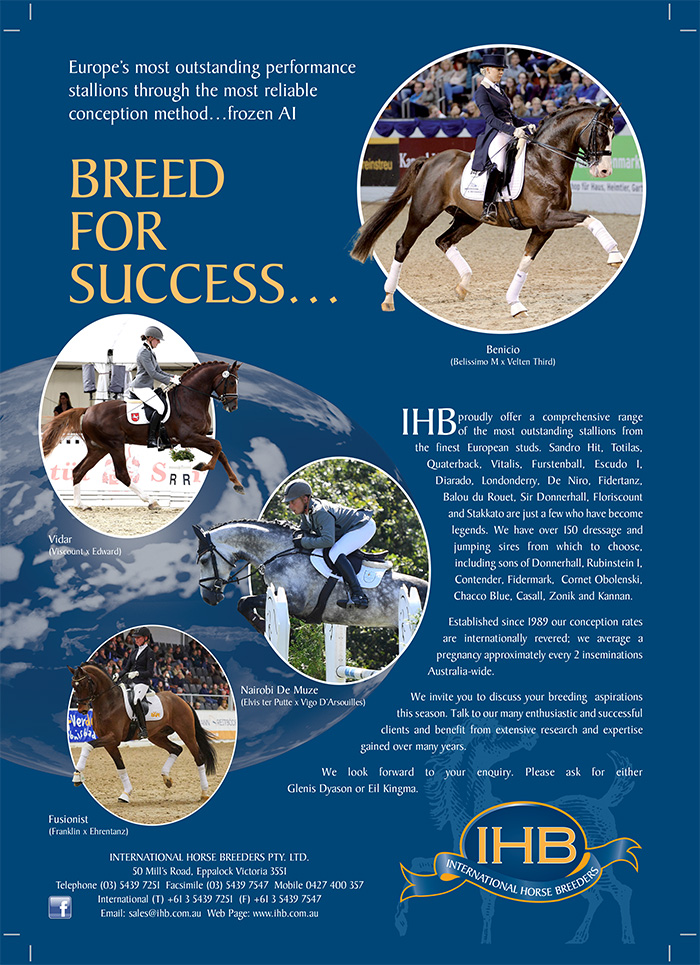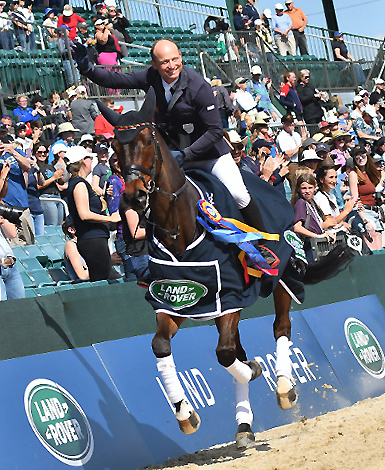
A victory lap in Kentucky for Michael Jung and Chipmunk (Photo – Michelle Dunn)
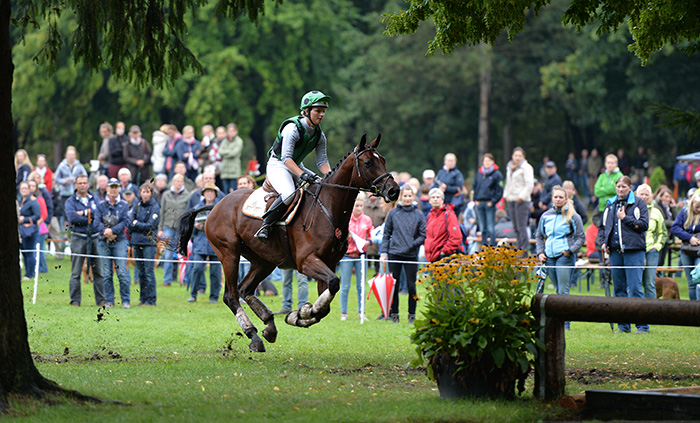
Chipmunk was a young eventer star with Julia Krajewski (the Tokyo gold medallist), she rode him to victory in the five year old eventer class at the Bundeschampionate. At the time we noted the Hanoverian Chipmunk, was by the Contendro I out of an Heraldik xx mare which meant that Chipmunck carried 45.7% Thoroughbred and Arabian blood.
THM asks why the German is such a star…
The latest news from the USA tell us that Magical Michi is back – although in truth he never really went away, it was just that his competition career was curtailed, like so many other eventers, by covid.! After a three-year absence he made the trip to compete at the Land Rover Kentucky Three-Day Event a month ago – and he brought with him the 14-year-old Hanoverian gelding fischerChipmunk FRH (Contendro I / Havanna) for his first-five star. The result never seemed in doubt with the pair grabbing the lead in the dressage in top spot with a score of 20.1.
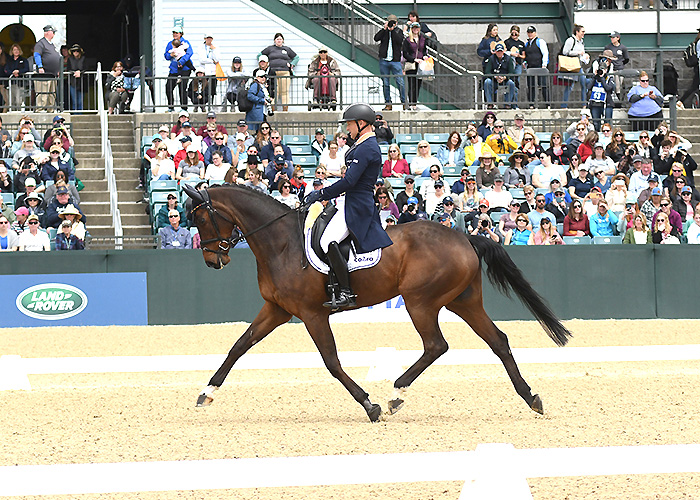
A start-to-finish win! (Photo – Michelle Dunn)
Michael was delighted: “I’m very happy with the test. I think that was the best I’ve ever had. It feels great to be back in Kentucky. It’s a wonderful place and I feel very welcome here. ”
“I really like [Kentucky] and have great memories here, and I feel like the horses like it also. You have perfect conditions with the all-weather arena, a nice stadium, and the cross-country is very beautiful.”
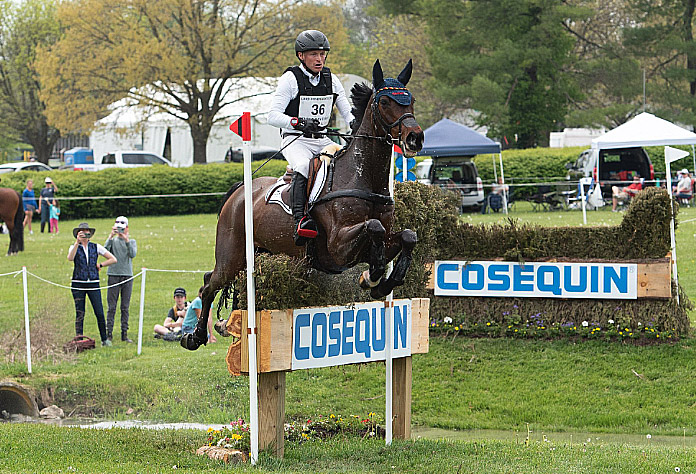
Clear no time cross country! (Photo – Michelle Dunn)
This is Michael’s fourth win on the Kentucky bluegrass, making him second only to the legendary Bruce Davidson in wins here (Bruce has five). It was his 11th CCI5*-L victory, which ties him with Mark Todd. Only the renowned British event rider, William Fox-Pitt, has more, with 14.
“Of course you always try to do your best, that’s why you wake up every morning and go to stables in minus 20 degrees, and in the rain, and in the heat,” Jung said. “It’s a very special moment for me, and I have to give thanks for my whole team in the background — helping train the horses and bring the horses to this level. And big thanks to the fischer group so that we can keep this horse in Germany and make it so that I’m allowed to ride such an amazing horse.”
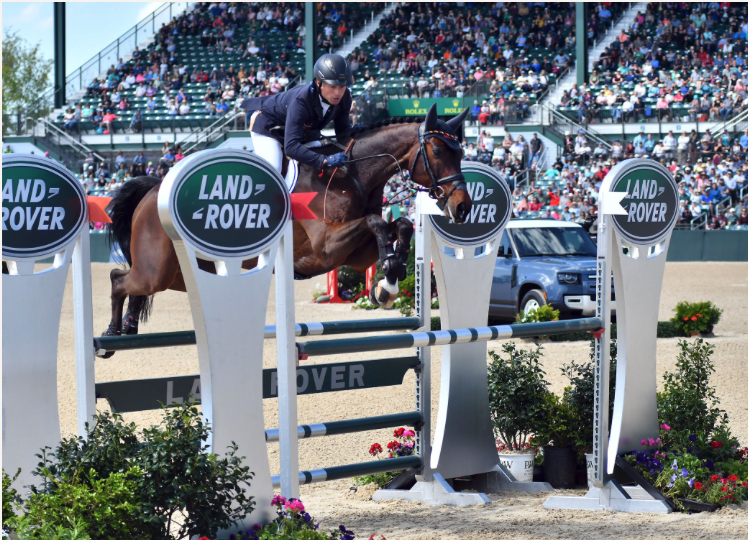
Champions again in Kentucky (Photo – Michelle Dunn)
Photo journalist, Rebecca Ashton, asked Michael:
What makes a great rider?
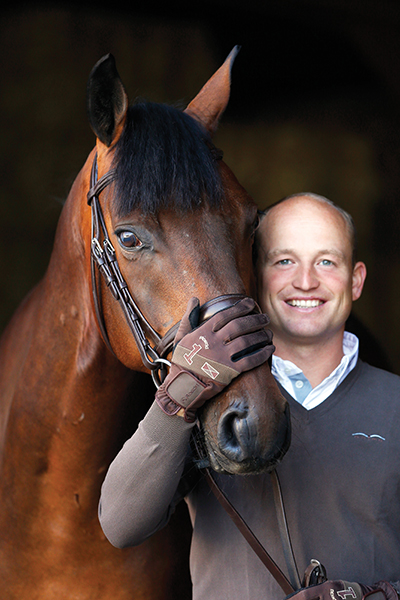
“I think a great rider is a rider who can teach the horse and has a good feeling for the horse, and you need a feeling for how good the horse is, and the prospect of the horse. Sometimes you have to be a bit more relaxed the first two, three years and not give them too much pressure because later after three, four years, he’ll be a top horse at the high level. But if you try to win when he’s six, seven or eight, maybe it’s too much for him. With some other horses, you can win much more easily at the easier competitions.”
“So it’s knowing how much pressure a horse can take and knowing when to back off.”
So what makes a great event horse?
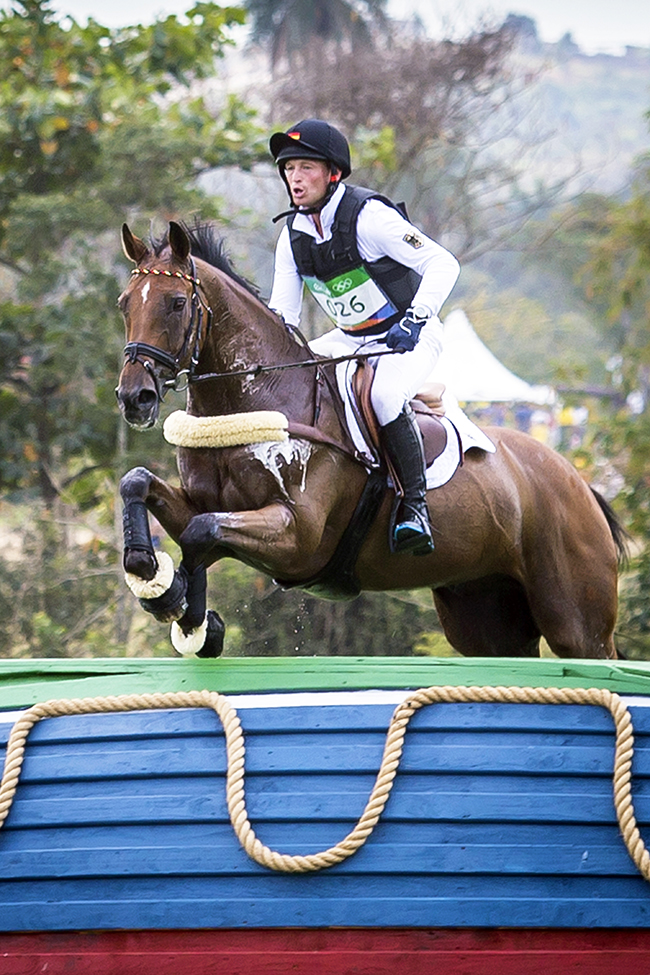
One of the truly great horses, Biothesque Sam
“The problem is you have three disciplines – and you need all three. In the beginning you can win a lot of competitions when you do the one-star, two-star, three-star when you have a horse that is not really a Thoroughbred-type horse and has more talent in the dressage and show jumping. But later to win the big classes, you need a horse that has a lot of Thoroughbred. So with this horse you might win nothing for three years, but then later you can win Burghley or Badminton. You have to think a bit differently about what you want to do. If you want to win the European Championships for the Juniors or Young Riders, you need a different horse. In relation to our breeders, it’s easier to breed a show jumping horse and sell him for much more money when he’s three or four-years-old than an eventing horse. You might still breed a good eventing horse, but you get no money. It makes totally no sense to breed eventing horses financially, and it is difficult to explain to breeders why they have to breed eventing horses.”
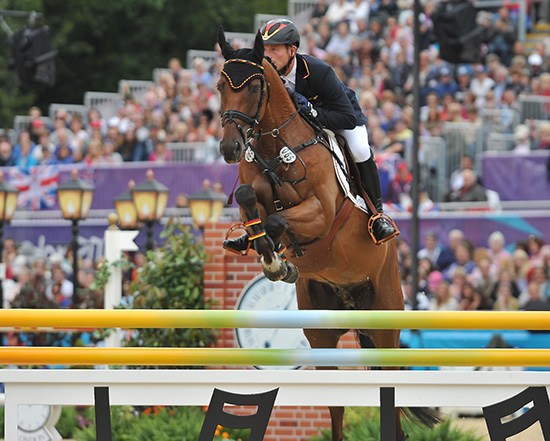
Sam showjumping and yes, he always crossed his front legs…
story continues below the advertisement
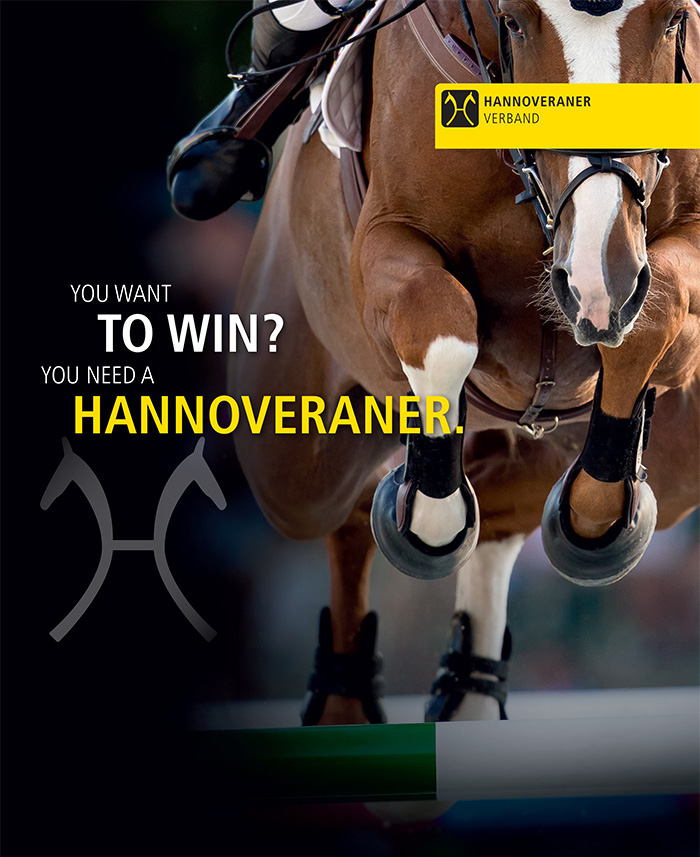
You obviously have to do dressage with the eventers, but how far do you take this?
“We have two things. One is the real dressage. You have to learn this, that every step is there where you want it. The other side is that the horse and you are in a very good partnership. The horse understands what you want, and that when you put your leg on, you get a good reaction. All these things, and also when you have the dressage saddle on the horse, you can do nice dressage work. Not dressage work like movements like shoulder in and half pass, but dressage work when you work together with your horse, that you school your horse to accept your aids, and is listening and reacting very quickly. These things are very, very important for the cross country.
I asked my pal Jan Tönjes, who edits Germany’s premier equestrian publication, St Georg (and I should point out Jan’s first love is eventing) what he thinks makes marvellous Michi so special…
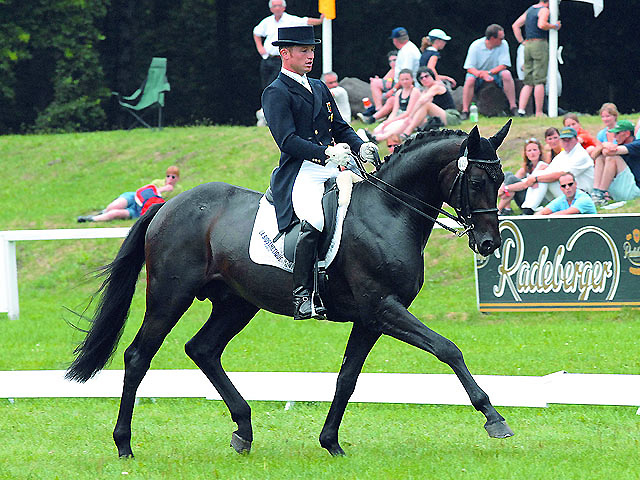
Michi and a young Grafenstolz TSF
“The answer is: He is supernatural, a god. I’ve known him from the times when he wasn’t yet Super Michi, but only an upcoming young rider with as much talent as guts, tons of it. And way back then he was always a man who wouldn’t talk too much, but only focus on his next ride, be it a puissance, a 3* or a four year old in a stallion show.”
“As to dressage: The most amazing thing I ever did with Michael was on a stallion show at Birkhof (Jan is in great demand as a commentator at stallion shows – he is also a breeding expert) when he was riding Grafenstolz TSF, then the world champion of young eventers. His parents Brigitte and Jochen came into the arena first with one of these small but high tables you can lean on while having a chat at a garden party. That table was put on the diagonal, some three strides out of the corner. They had a bottle of champagne on the table, and glasses in their hands: When they were saluting each other – cheers!”
“Michael who had done some cantering and a gallop down the long side, turned on to the diagonal, jumped over his parents’ hands with the glasses and then afterwards on the same diagonal rode some 11 (maybe only 9, but all well through) one tempis. The audience was completely silent because they obviously couldn’t really believe what they had just seen.”
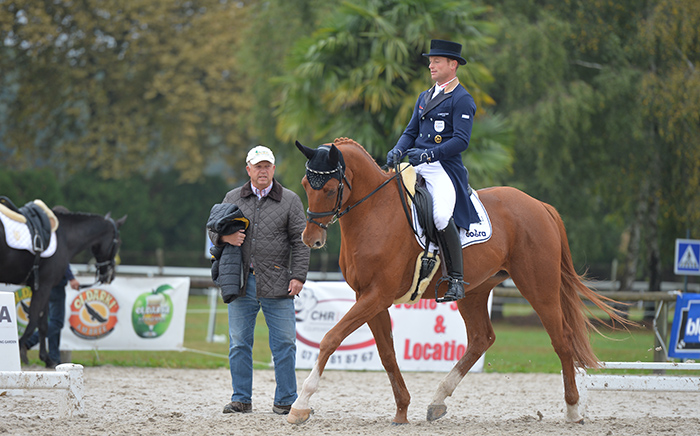
Michael working with his father, Joachim
“This is Michael’s way of working horses, having them through and supple, obedient and willing to work. He doesn’t squeeze them into a frame, he asks them to work, and since – and I think this is the real background of his enormous success with any kind of horse, from the cat Roxie to the stiff lorry Halunke – he is always in perfect balance with the horse he gives them the confidence they need no matter what effort comes next.”
Because Michael Jung has taken the sport to a new level, he is a problem for the troglodytes of eventing, the ones trapped in the past who warn, TOO MUCH DRESSAGE will RUIN your cross country. For many years this has been the refrain of British media identity (and former World Champion) Lucinda Green.
Jan Tönjes tells a lovely story that illustrates this point:
“A couple of years ago, Lucinda Green did an article on Michael. Julia Rau did the pictures and picked Lucinda up at the Stuttgart airport. Julia told me Lucinda was really excited to finally meet a German eventer who doesn’t focus too much on dressage but rides ‘British’ i.e. letting the horse run through the cross working out how to tackle with the things that are asked, there on the spot. According to Julia, it was the disappointment of the year for Lucinda when Michael could tell her the number of strides between all the fences of all the courses he had ridden that year – ‘Seventeen long ones, then two shorter ones to make sure the horse is back on the aids before the left turn to the ditch which then had seven straight forward strides to the Trakehner which was completely in the shadow so you might ride eight strides if they hesitate for a little moment.’”
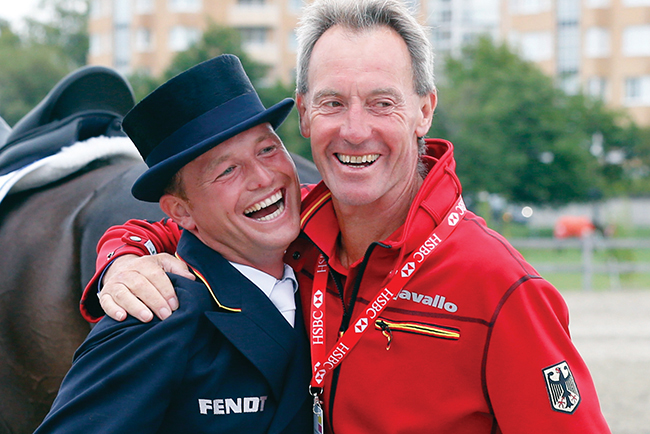
What does his coach Christopher Bartle say – why is Michael so special?
“His will to win, his self belief and trust in his horses. He is not afraid of making a mistake, he doesn’t play safe. Michael is, of course, technically very good but he is always interested in the detail and is always wanting to learn more and be better. He is a coach’s dream partner. He has a great team around him at home but he is also a great team player.”
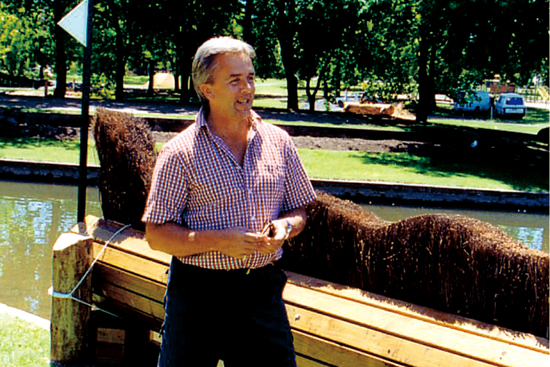
The world’s best eventing course designer, Mike Etherington-Smith loves nothing better than to stand quietly in the background on cross country day and watch how his courses ride, and he sees M. Jung for what he really is:
“Every so often a truly outstanding athlete comes along and he/she has the very rare and exceptional quality, ‘time’. Everything looks effortless, smooth, simple, rhythmic, and a pure joy to watch. It is more than just talent, it is motivating, it is inspirational, it is pure class, and we are fortunate to see all this in Michael and his relationship with his horses and how they perform for and with him. Watching him ride across country on his various horses is a lesson for us all. His balance, the way he makes courses look so simple, and the confidence he gives his horses is second to none.”
And what does all that mean for the course designer?
“The Michael Jungs of this world make things pretty tricky for us Course Designers. How do we test their skills in a way that remains fair to the horses? We need to make them have to think how they are going to tackle a course or a particular combination or series of fences and then make them have to make decisions based on what their horses are telling him as they are going round, whilst at the same time we have to recognise that there are not many Michael Jungs. Course designing has had to change over the years, to adapt the new format without Roads & Tracks and Steeplechase, and yet still provide enough to ‘test the best’. In planning a top level course we all try to provide a sufficient test to examine the big guns whilst at the same time looking after those stepping up to the level for the first time. Whether we even get close, is for Michael to answer.”
Young Michael’s talent was apparent at an early age.
Even before he was 10 years old, eventer Michael Jung was impressing the best in the world.
After Jung polished off his Rolex Grand Slam win, editors at the German magazine St. GEORG dug up the first photo they’d ever run of the superstar, from 1992—the year Jung turned 10. The legendary George Morris was writing a “Training Tips” column in St. GEORG, in which he critiqued photos submitted by readers (much like his Jumping Clinic column in Practical Horseman).
“Readers would send a picture, then editor-in-chief Gabriele Pochhammer would send them to the States, and George would return them (some months later) with a comment on what he saw on the picture,” said St. GEORG Editor-in-Chief Jan Tönjes.
And Michael’s father, Joachim, sent in a photo of his son, which was then published in the Dec. 1992 issue.
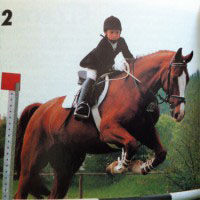
According to Tönjes, George Morris commented this on Michael’s photo:
“The bottom is perfectly well out of the saddle with the legs in a very good position, with the heels down and the tip of the toes pointing towards the outside. The entire position of the leg is by far better than most of the older riders, with a good contact to the horse’s body.
“The hands are following correctly the horse’s movement but could give a little bit more rein. All things considered it is a photo showing superb style from which a lot of experienced riders could learn a lot.”
Image courtesy of St. GEORG.
Michael Jung has already achieved so much in his equestrian career, how much more is to come, and will his path lie in dressage or showjumping or eventing…
ends
